 9Likes 9Likes
-
 3
Post By kotamarudu
3
Post By kotamarudu
-
 1
Post By kotamarudu
1
Post By kotamarudu
-
 2
Post By kotamarudu
2
Post By kotamarudu
-
 2
Post By kotamarudu
2
Post By kotamarudu
-
 1
Post By kotamarudu
1
Post By kotamarudu
 |

13 Nov 2020
|
|
Registered Users
HUBB regular
|
|
Join Date: Aug 2007
Location: Australia
Posts: 65
|
|
|
Indonesia. Tambora- the Mountain that Shook Up the World.
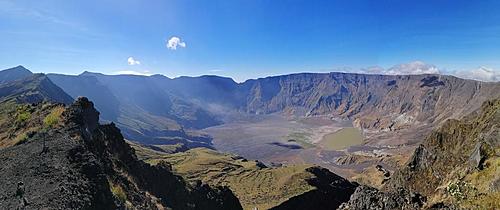
The Mountain that Shook up the World. Part 1.
On April 15, 1815 the little known island of Sumbawa, in the Dutch East Indies, played host to an event of global proportions. Mt Tambora blew its top and catapulted 150 cubic kilometres of its brooding mass skywards in an act of monumental malevolence. A mountain that Sir Stamford Raffles had measured to be 4200 mts high was reduced to 2800 mts. It now sported a crater one kilometre deep and seven kilometres wide. The explosion obliterated the entire population of West Sumbawa, its culture and language lost - forever.
News of the disaster did not travel fast. There were no eye witnesses to recount the event. Loud booms were heard 2600 kilometres away in Batavia. The mystified inhabitants sent a detachment of soldiers to Banten, thinking there had been an attack. Ash began falling in Bali, Lombok and Java. Two English ships reported sailing through a massive sea of pumice stone. Something big had happened - but what?
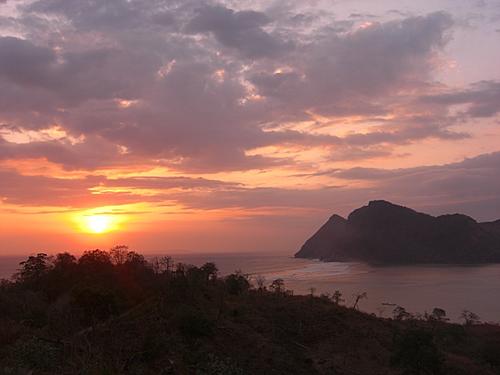
On the ground there was utter devastation. Perhaps 30,000 people lost their lives immediately. Those outside the critical zone were to suffer terribly from disease and, eventually, from starvation. The eruption has been estimated to be the equivalent of a 22 gigaton blast of TNT. Thousands of square kilometres of Sumbawa and neighbouring Lombok were covered in ash up to two metres deep. Water sources were totally polluted. The simple act of drinking became a lottery where the booby prize was death from cholera. Arable land ceased to exist so people starved or became refugees living the most precarious of existences.
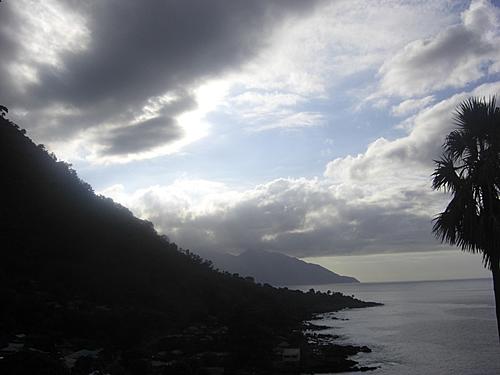
In far off Europe and North America the population was blissfully ignorant of the Tambora disaster. All they realised, as the months passed, was that the weather seemed to be getting a little cooler, the sunsets a lot more spectacular and the days more hazy and murky. As the year went on conditions worsened. The new year, 1816, saw an intensification of the unusually cold conditions. Each passing day the sun shone more weakly from behind an ever-thickening veil of volcanic debris which, by now, had circled the globe. The ground froze; nothing grew as expected. Crops either failed completely or yields were drastically lowered. Throughout Northern Europe and North America famine devastated entire districts. In London the River Thames froze. 1816 soon became known as “The Year without Summer.”
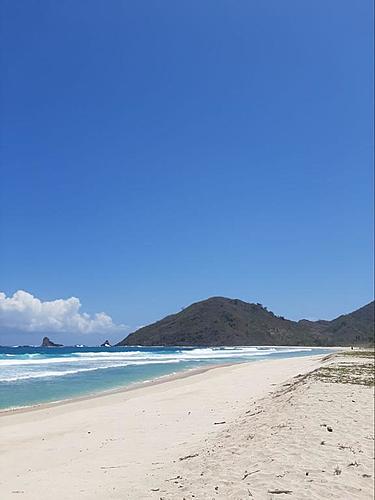
****************************************
My first encounter with Tambora was in April 2009. I rode a Honda Vario over from Bali and, after a week on the road, I found myself turning left at the roundabout in Soriutu town and heading north-west, bound for Tambora. It lay about 100 kilometres distant, along the decayed ribbon of bitumen that was once a road. After four hours of torturous, snail-pace riding I had an “off” and lost a bit of bark from my knee; no damage to the bike save a scratched muffler. All good.
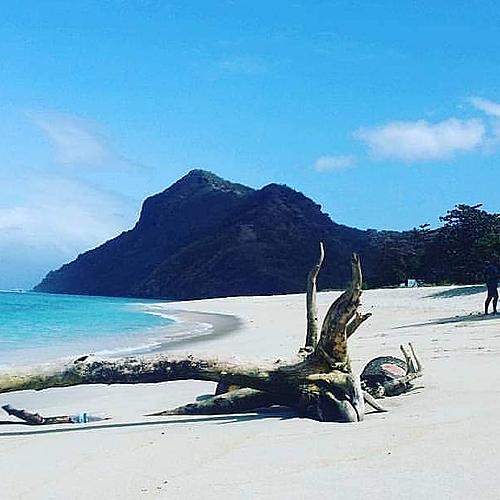
I think I was one of the first outsiders to climb Tambora. It was an epic trip. Just two guides and me. Drenching rain for hours on end. Up and back in thirty-three hours. Little sleep, maximum effort. But the view from the crater lip at dawn? Words fail me. You just have to experience it for yourself.
Since that first trip I’d made two more attempts to summit but both ended in failure. In 2012, aboard a Kawasaki KLX150, I attempted to ride from Doro Ncangga in the west via a track that led to a shelter located at 1800mt. I was ill-prepared for the attempt. To begin with, I had my luggage strapped to the fuel tank which restricted my manoeuvrability. Then there was the track. It was dry season, so lots of deep sand. I really struggled up the steep sections and had a number of minor offs. It was hot and exhausting work extricating the bike and, to my alarm, my water supply was looking rather light on. Furthermore, the bike was really difficult to re-start due to a flooding and perhaps vapour lock. In the torrid heat the exertion required to keep moving onwards and upwards was debilitating. Around mid-afternoon, after another spill, I bailed out and headed for the coast to lick my wounds.
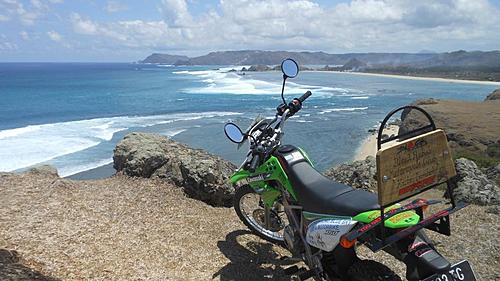
I went back again to Doro Ncangga in April 2015 better prepared and wiser. With a functional luggage rack, plenty of water and a bank of experience to draw on, I charged up the track without incident. I took a break at Pos 2, located at 900mt. Refreshed, I pressed on. Pos 3, was just five kilometres away. The track was getting steeper but it was still manageable. I descended a deep gully and made it up the other side - just. I pressed on. Another steep downhill led to a dry stream bed bordered by large trees clothed in a mantle of vines and epithytes. It was eerily dark down there; I made it to where the ascent levelled out a little and had a rest. It was not yet 11 am. Pressing on I reached a point about two kilometres past Pos 2, took a wrong line and snookered myself, largish rocks in front of each wheel. I made a couple of valiant attempts, with plenty of right hand, to free myself but, alas, nothing was happening at the back wheel.
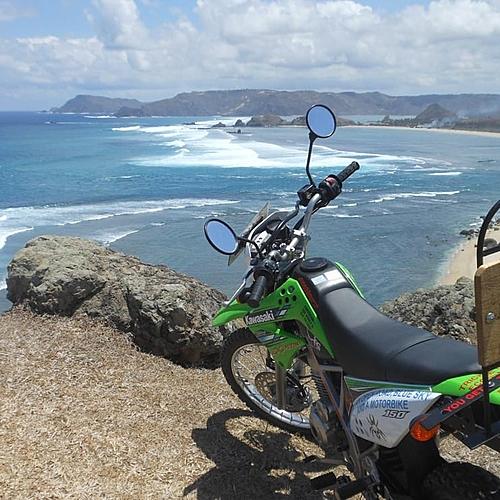
I got off. The clutch housing was scalding hot. There was little free play at the lever. What to do? Wait. Let it cool down, adjust for free play and hope I didn’t have a burnt out clutch. I sat beside the bike, lay back and took in my surroundings. I was on a ridge that dropped away quite sharply to the right. It was savannah country. Some sections of the track had been bordered by grasses up to two metres high. Here the grass was shorter and I had an unimpeded view of the valley below. To my alarm the weather was closing in. A band of cloud was slowly making its way toward me. A stiff cold wind sprang up propelling a maelstrom of writhing, tumbling mist ahead of it. I was soon enveloped in its clammy embrace. Visibility was compromised alarmingly - to perhaps just 50 metres. All I could do was wait and ... hope.

I waited an hour. There was no sign of the cloud abating. Even if I could get the bike moving, continuing upwards might prove futile as there could be a white out at the crater lip. I turned my attention to the bike. The clutch housing was just warm to the touch - good. I managed to get a bit of free play at the lever - good. I started the engine, engaged first and, with hopes high released the clutch. The bike moved! I was mobile again. I turned around and headed back down the mountain, worried about making it up the two steep gullies before Pos 2. Throwing caution to the wind, I attacked each gully with gusto and, heart thumping, made it up to level ground without mishap. Upon reaching Pos 2 I took a break and a swig of water before heading downhill to the bitumen twelve kilometres away.
When I reached the roadway it was early afternoon. I took the opportunity to test the bike thoroughly for clutch slip. On the flat, in top gear with minimal throttle, there wasn’t a problem. But, as soon as the engine was put under load it roared - but in vain. There was no way I’d be able to tackle that track again so I reluctantly headed home for Lombok and repairs.
And so to July 2019. New Zealander, Mike Betts, also on a KLX, and I, took off from Kuta, Lombok and made our way up the east coast to Pelabuhan Kayangan to catch the Sumbawa ferry. Our luck was in. As we approached the harbour we came across a line of trucks exiting the Port gates and we spied the ferry tied up at the dock. The ticket for the ninety minute crossing to Poto Tano was an absolute steal at just AUD$5.50.
We joined the line of bikes waiting beneath an awning. Blue uniformed ASDP Officials patrolled the parking area barking orders to truck and bus drivers, arm waving and pointing vigorously. Passengers trooped by lugging cases, boxes and kids. Vendors strolled by hawking rice and chicken, smokes, drinks and snacks. An old blind man, being lead by a young lad, begged for alms. Kiosk operators did a busy trade. All eyes were on the official controlling the chain which blocked access to the ferry. Trucks and buses had priority. We got to fill up the gaps - if any! It was a tense situation. There were thirty bikes ahead of us, fifty behind. Would we make it?
As soon as the official began to approach the chain helmets were donned and engines roared to life. The chain was unhooked. I latched on to the stream of bikes heading quayside. Just as I exited from beneath the awning, out of the corner of my eye, I noticed the official move to re-attach the chain. Mike’s exit had been barred! I made a quick u-turn and called out in Indonesian, “Hey bro, what about my mate? We’re travelling together!” Somehow Mike had got held up in the rush to exit and was now a few bikes adrift of the chain. The official spotted him, gave me a nod, unhooked the chain and waved Mike though. We were on!
I’ve always loved the Angkatan Sungai Danau Penyeberangan (ASDP) ferries. This Government- run institution stitches the world’s largest archipelago together. It’s vital to trade and to the lives of the “orang kecil”, the “little people”, for whom the cost of air travel is way out of reach. Throughout eastern Indonesia there is constant movement of people back and forth between the larger and smaller islands. The former have universities and jobs in the developing tourism, agriculture and service economies; the smaller have subsistence farming and fishing - but little else. So, people migrate for work and study opportunities or to conduct business as small traders. Consequently the ferries are usually crowded and, I guess, sometimes overloaded. Indonesia is possibly the only country in the world where, if you lose your passport as the result of a shipping disaster, you can get a new passport at a discount rate. Some may find that alarming, but not me. I’d much rather take my chances in the sea with the sharks than be on a jet plane plummeting to terra firma!
The vehicle deck was packed solid with trucks, buses and bikes. The waves, if any, could do what they liked; nothing could topple over. We contented ourselves seated in the shade to stern, our ferry’s twin screws scribing a trail of turbulence on the mirror surface of the Alas Strait. Little islets - rocky, brown, bare - poked their heads up to port and the looming bulk of Sumbawa appeared ahead, its mountainous spine cloaked in heat haze.
After a ninety minute crossing we entered the sheltered bay that is Poto Tano. Monte Carlo it is not. Just two berthing ramps, some warehouses, administration buildings and a Bugis stilt village at bay’s end. The vehicle deck was a hive of activity. Truck drivers revved their engines, passengers shoe-horned their way aboard buses, motorcyclists donned helmets and loaded their wives and kids - three on a bike was common, four less so. At last the ramp came down and we were free.
Attachment 24557
We roared out the port gates along a road bathed in sunshine. The run to our lunch stop at Kencana Beach Hotel took us inland through scrubby hills, fields of corn and then along the coast. We passed Bungin Island, reputedly the most densely populated spot on earth where, if you want to get married and build a house, you first have to collect enough coral to extend the island. Thus it is an organic entity that has been expanding for years, its Bugis inhabitants content to live their lives anchored to the unchanging rhythm of the tides.
We cruised through dusty Alas township weaving our way in and out of the knot of pony carts, pick-ups and scooters that jostled for space outside the cavernous market. Utan came and went and before long we reached the coast at Batu Gong. In the far distance we spied the bulk of the Tambora Peninsula, its outline hazy and indistinct against the blue of the sky.
Kencana Beach Hotel sits on a quiet cove 12 km west of Sumbawa Besar city. It’s been around for years and has an excellent restaurant. Mike and I were greeted warmly and we soon tucking into to a delicious lunch washed down with superb local coffee. We were the only diners as the hotel was devoid of guests - Sumbawa has never been front and central in the Department of Tourism’s thinking. But that’s ok!
We said our goodbyes - “Till next time” - and motored up the rutted driveway to join the main road again; next stop, Lesehan Telok Santong, a 100 km further east for a catch up with old friends and to have a coffee.
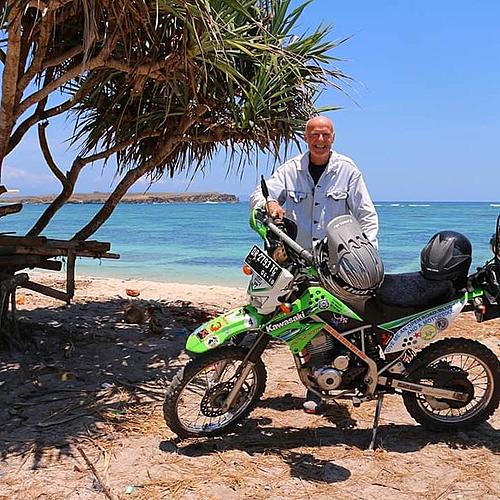
Last edited by Grant Johnson; 15 Nov 2020 at 00:39.
Reason: fixed attachment glitch
|

13 Nov 2020
|
 |
HU Founder
Veteran HUBBer
|
|
Join Date: Dec 1997
Location: BC Canada
Posts: 7,366
|
|
|
Great story, thanks!
__________________
Grant Johnson
Seek, and ye shall find.
------------------------
Inspiring, Informing and Connecting travellers since 1997!
www.HorizonsUnlimited.com
|

13 Nov 2020
|
|
Registered Users
HUBB regular
|
|
Join Date: Aug 2007
Location: Australia
Posts: 65
|
|
|
Glad you liked it. I'll add some more photos.
|

14 Nov 2020
|
|
Registered Users
HUBB regular
|
|
Join Date: Aug 2007
Location: Australia
Posts: 65
|
|
|
Indonesia: Tambora, The Mountain that Shook Up the World. PART 2
Riding Sumbawa that afternoon was a joy. Blue sky, a whiff of breeze, smooth blacktop, light traffic and scenery as varied as it was beautiful. We passed through neat villages slumbering in mid afternoon torpor. We skirted around and through low, scrubby hills overlooked by jungle covered saw-toothed mountains. At times the road passed through fields of corn or along the sun-drenched coast. The sea was impossibly blue; fishing boats, both at anchor and pulled up on the beach, waited for the turn of the tide and their next call out.
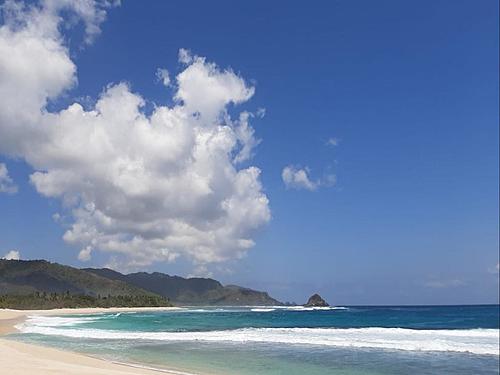
We pulled into Lesehan Santong, a truck stop sitting astride a tiny inlet. Operated by Ibu Endang and her family I’ve seen it grow and prosper over the years. It serves the best barbecued fish on the coast. Kicking back in a little pavilion that nestles in a pretty mangrove-fringed bay, cold drink in hand, the heady aroma of fish cooking over the coals - easy to get used to!
Fed and watered we took off -‘until next time’- and motored east, ever east, sweeping through the bends, slicing through air, trundling through sleepy settlements before reaching the sea again at Salleh Bay to begin the glorious climb over the range that separates the coast from the Soriutu Valley. The remains of last monsoon’s landslides bore witness to truth behind the frequent roadside warning signs. Engine pulling hard in 3rd, dropping back to 2nd in the hairpins, the glorious sweep of Salleh Bay to the left with the mountain range to the right silently watching our progress to the top of the pass - food for a rider’s soul.
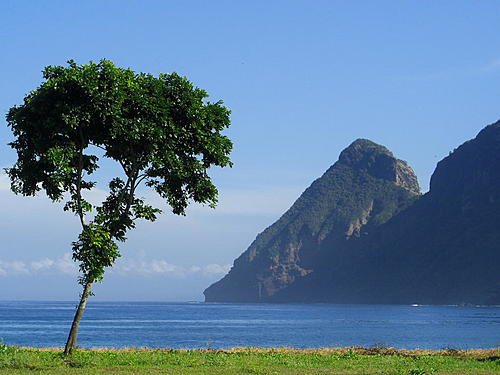
And then the descent. A series of sweepers taking us to the floor of the broad Soriutu Valley and its fields of ripening corn and rice. We passed by cobs laid out to dry on blue tarps and gangs of conical-hatted workers toiling in the rice fields in the late afternoon light
There was no way we were going to reach the National Park before nightfall. We pulled in to get petrol at the roundabout in Soriutu town and and inquired about lodgings for the night. The old chap serving us was super friendly. He directed us to the ‘Homestay Fadillah” so that’s where we headed. Upon arriving we were met by a jolly woman, Ibu Fatima, who showed us to room with its own facilities and a fan - all that we needed. The tariff was very reasonable: IDR150,000K per night, breakfast included.
There is nothing more enjoyable after a long, hot ride than to slosh dipper-full, after dipper-full of cold water over yourself, soap up and wash away the patina of the day’s exertions. Totally refreshed, Mike and me headed out to eat. We found a likely looking “Masakan Padang” restaurant and parked out front. This style of restaurant originated in West Sumatra and has now spread all over Indonesia. The food has already been prepared and is on view in a glass fronted cabinet. A lace curtain prevents ingress of flies. Rice is always on hand in the rice cooker so it’s just a matter of selecting from the array of dishes - various types of fish, chicken done in different styles, beef, eggs two or three ways, tofu, tempeh, corn fritters, potato cakes, beans, fried white bait, cassava leaves done in coconut and vegetable dishes. Sitting down and hoeing in - instant gratification - it works for me!
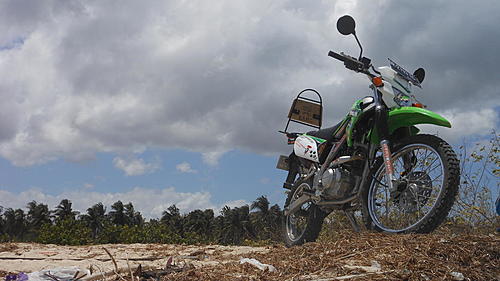
Back at Homestay Fadillah we met Fatima’s husband Rizal. He had a Honda CRF250 and was interested to hear our plans. He heard us out but then suggested we try an alternate route to the east that began past the village of Piung, about two hours ride away via a ‘good road’. He assured us that the National Park track was good and that our bikes could reach Post 3 - just ninety minutes climb from the crater. They idea of trying a new route appealed greatly to us so, with Rizal’s recommendation fresh in our minds, we retired for the night in preparation for an early start next day.
Up before dawn we took our coffee and banana fritters on the veranda. The morning chill had deposited a film of dew on the bikes. We bade farewell to Fatima, motored out the yard and turned east into the rising sun. A few people strolled the road sarongs wrapped tightly around their shoulders. Columns of mist rose from the fields. We sliced our way through the stillness accompanied by engine song and the thrum of our tyres. Beyond Kore village the road swung left and took us, via a steep defile, to pretty river valley which we followed for miles.The road, bordered by padi fields on the right, was shaded by stands of bamboo and giant trees within whose shadows potholes lurked.
We weaved onwards and eventually reached Piung village. In and out in a trice - a “blink and you’ll miss it spot” - our progress slowed as the road became a buffalo track of bull dust and lumps of rock. It was hot now. The land was dun-coloured and desiccated: the only sign of life a circling raptor on the lookout for a snake or lizard. In the near distance a couple of mini volcanoes rose from the scrubby thorn country. Tambora itself lurked up ahead hiding behind a barrier of cloud.
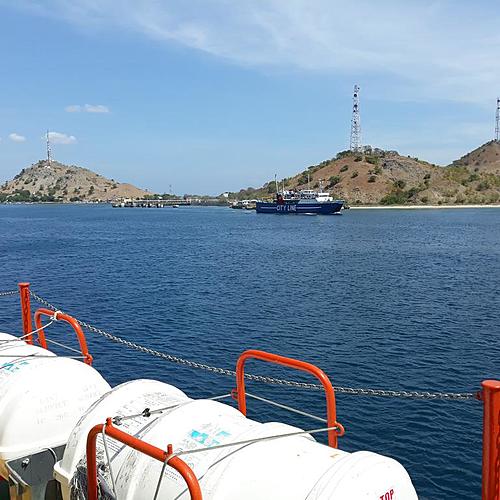
We rounded a bend and there it was - the arched gateway announcing the entrance to “Taman Nasional Tambora, Piung.” An impressive sign board illustrated the route upwards and indicated the distances to the various posts and their heights above sea. Post 3 at 1800mt was 21km distant along a ‘good’ track - whatever that meant!
After a brief spell we took off through deep sand bordered by spinnifex and thorn bush. We came to a junction. The main track veered left so we followed it and found ourselves hopelessly snookered. We’d arrived at a deserted sand mine. The black, volcanic surface was littered with holes, depressions and tracks - a sorcerer’s maze salivating at he thought of entrapping two naifs. We turned back and took the narrow track that led straight on.
The going was easy at first but that didn’t last long. Once the track started to climb it became increasingly chopped-up, rutted and loose. There were sections of loose scoria the size of lemons and, over the years, the monsoon had eroded deep channels on both sides of the track; It would have been a nightmare to get a bike out of one. All around was savannah country. Swathes of brown waved in the gentle breeze, clumps of thorn bush stood marooned in an ocean of grass. The thought of a bushfire crossed my mind but was discarded - I had enough to worry about with the track!
Up ahead Mike was making a better fist of things than me. He was more skilled off road and with larger wheels providing an extra three inches of ground clearance, was able to pass obstacles that were beyond me. I had a couple of minor “offs” and required his help to get mobile again. We made it to Post 2 and took a breather. It was nearly 11am. We’d traveled 11km - just over half way - but the steeper part of the climb was still ahead.
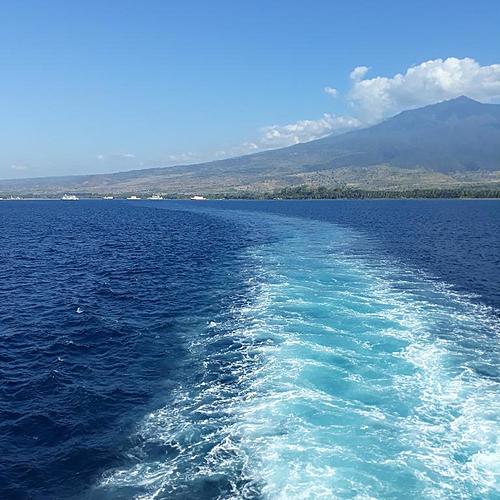
We set off feeling refreshed physically but somehow I couldn’t shake the tension and anxiety that had been creeping up on me since we’d left the bitumen. Was this going to be another failed tilt at Tambora? The track was a lot steeper now. It required quick thinking, precise judgment, skill and momentum - leaving out one element was likely to result in trouble.
About 2km past Post 2 I stuck trouble in spades. After choosing the wrong line on a steep rise I found myself sliding backwards. Too slow to react I found myself snookered with a large jump up in front of the back wheel and a smaller one ahead of the front. Hindsight is a wonderful thing. Instead of waiting for Mike to return I reached for a fistful of throttle and dropped the clutch. The back tyre clawed at the obstruction to no avail. I tried again. And again. Nothing. And then there was nothing at the back wheel. Clutch! I had no clutch! Overheated? Hopefully. Destroyed? Possibly. In trouble? Yes.
Mike returned from up ahead. We extricated the bike and moved it to a flat area where I could work on it. The clutch housing was extremely hot but I couldn’t detect any burnt smell. There was no free play at the lever. Maybe, just maybe, if we waited an hour for things to cool down and, if I adjusted for free play, all would be well. Hopefully!
There was nothing to do but wait. The sun beat down from on high. The only clouds were up ahead in the direction of our goal. We sat in the dirt and discussed our predicament. If the clutch was ‘cactus’ we were going to need a 4WD, or some extra manpower, to get the bike back down. Or, we were going to have to find parts somewhere and replace the clutch “in the field”. Either way it was less than ideal. This trip was not working out the way it was supposed to. Mike’s disappointment was evident. Seeing Tambora’s crater was for him, an unrealised ambition whereas I’d already had the thrill that comes from staring into the abyss left by the explosion that “shook up the world”.
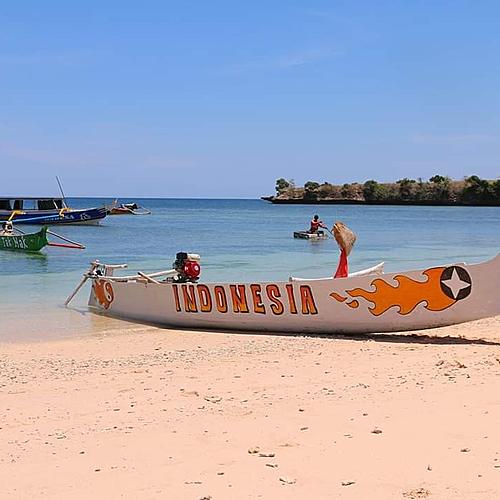
After waiting an hour I fired up the bike and dropped the clutch. Nothing. I jumped on the back of Mike’s bike and away we went. It was damn uncomfortable on the back. The seat is paper thin back there and the going was tough. I was clinging on using my knees as well as arms, trying to roll with the punches and play my part in keeping the bike upright. Mike’s skill got us down in the end. Our relief on reaching the bitumen without mishap was palpable.
We headed for Piung village in the forlorn hope we might find some KLX clutch plates. We trundled the pitted main street and spied a few blokes squatting around a motorbike, the disembowelled guts of its engine laid out on rag on the ground. Our hope of sourcing KLX clutch plates was put to rest. We could get them in Bima - five hours away. Damn! Then a young bloke piped up. “Why don’t you go to the Park Headquarters? They’ll be able to rescue your bike.”
Neither of us had spotted the Park Headquarters on the way through that morning.
“Park Headquarters? Where? Soriutu?” I asked.
“No, just around the corner. Follow me.”
And sure enough, not 200 metres away back along the way we’d just come, our guide turned into a driveway and there sat a decent sized building. An impressive sign board tucked away in the yard, invisible from the road, proclaimed “Taman Nasional, Tambora. Piung.” How could we possibly have missed it? Still, at least it was out of the reach of wannabe vandals!
We explained our predicament to Rachmat Hidayat the only staff officer on duty as the others were out with the 4WDs fighting a fire. Rachmat made us a coffee and assured us that a rescue could be mounted next morning. In the meantime we could rest and that night sleep in his room. We were fed and over a meal chatted with some of the locals. There weren’t many people around as there was to be a wedding feast in a couple of days and everyone was busy with the preparations. We sat on the veranda and waited ... and waited. It was too hot to sleep. A few locals dropped by to chat. They assured us that the bike would be “evacuated”.

Around dusk the fire fighters returned in a pair of Mitsubishi Triton 4x4s. The fire was out but it had been a close thing. A late afternoon wind change had enabled them to wrest back control and eventually subdue the flames. Fire fighting, illegal logging and poaching were the three biggest issues faced by these men and women. Pak Abdullah, the senior driver, informed us that rescuing a broken down bike was “going to be a first” for them.
That night I slept like ten men and woke with the roosters. After a hearty breakfast of rice, noodles and fried eggs we took off with Pak Abdullah in command. He was a man in his 50s, filled with the quiet confidence that comes from “having seen it all before” in his particular balliwick. Mindful of Mike and the three Park Staff seated on wooden bench seats in the back, he drove in a careful, controlled manner, swerving expertly to avoid the worst of the potholes.
We turned off and entered the Park proper. With consummate skill Abdullah negotiated the steepest and most chewed-up grades. Sand, scoria or rock, the Triton, in low-low, bested them all. There was never a moment where I thought we might not make it through. We passed Post 2 and fifteen minutes later spotted the KLX all on its own, waiting patiently. Willing hands loaded the bike and sufficient ties were applied to keep any loadmaster happy.
We arrived back at Headquarters around noon. Pak Rachmat suggested that the bike could be transported to Soriutu and we could organise some spare parts from there. It was a perfect solution for us so we packed up and Mike followed us on his bike. I bought the Park Staff a couple of slabs of their favourite smokes for their kindness.
Back at Homestay Fadillah we unloaded the bike then headed off in the Triton for a slap-up meal and to say our farewells to these open-hearted blokes who had thrown us a lifeline.
They wished us all the best and drove off. We began our search for a bike shop. There was one just down the street. A dozen bikes were out front, half lined up, the other half being serviced by mechanics wearing the obligatory uniform - flip-flops, shorts and tee-shirts. The forecourt was smooth, oil-impregnated clay; hard underfoot yet slippery too. Trapped within its embrace lay hundreds of discarded nuts, bolts, screws and what have you. They glinted and sparkled in the sun’s setting rays; were they a portent of the treasure that lay inside - a set of KLX clutch plates?
The shop owner put paid to that fantasy with a shake of the head.
“Try down the road, at the roundabout.” he advised.
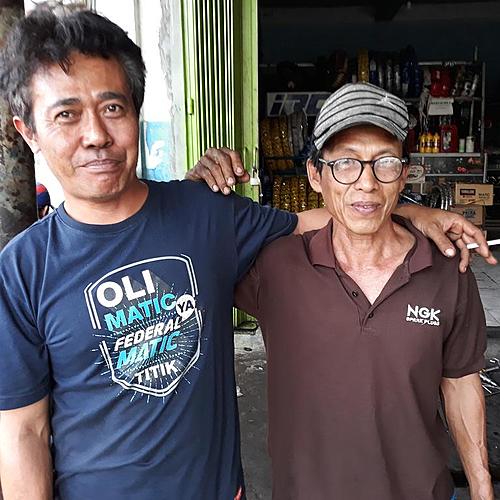
We found the workshop. Same scene, different result! They had the plates! The owner was from Java. As a kid he’d taught himself English by listening to Radio Australia. He burst into song with a spirited rendition of “Waltzing Matilda”, our un-official National Anthem. The world is indeed an amazing place! My bike was repaired, oil changed and chain cleaned and adjusted for the princely sum of AUD$22.
Last edited by kotamarudu; 14 Nov 2020 at 09:27.
|

14 Nov 2020
|
|
Registered Users
HUBB regular
|
|
Join Date: Aug 2007
Location: Australia
Posts: 65
|
|
|
Indonesia: Tambora, The Mountain that Shook Up the World. PART 3
Next morning we left before dawn. We had decided to revert to our original plan and head for Doro Ncangga. So, leaving most gear with Ibu Fatima, and taking only food, water and the bare essentials we headed out into the chill morning air. The road was smooth, the villages were just stirring. The further we went the smaller and sparser the hamlets. The air warmed, the sun shone, the sea sparkled, the breezes sighed. We bade good bye to the sea at Hodo village and a little further on stopped for petrol and a break We bought more biscuits and water. Park Headquarters were ten kilometres away.
We arrived at 8am and introduced ourselves. After a bit of “umming and arrhring”, and a phone call to Head Office, it was decided we had to pay the IDR150K entrance fee again which was fair enough. Receipts duly issued we fired up the bikes and struck out across the black-sand expanse opposite the Park Office.
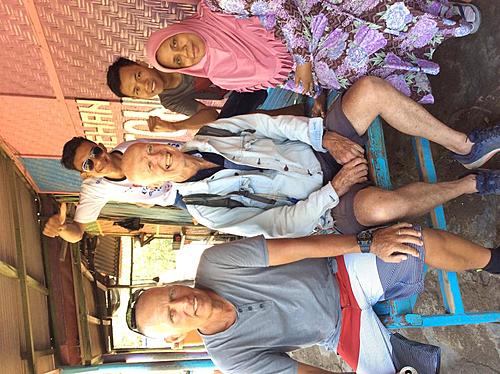
We made good progress. But sections of deep sand and loose rock necessitated feet to be ever ready for use as “out riders”. As we climbed the track narrowed and some deep channels, ruts and ridges appeared. We breezed on past Post 1 without mishap but shortly after I took a wrong line, slowed, unbalanced and toppled over. I put my foot down but couldn’t reach terra firma. I managed to get out from under the bike with nothing more than a dented ego.
We were in savannah country now. The track was bordered by thick grass sometimes too tall to see past. At times there were some ominously deep craters off to the sides - best not to think about them. Still, I could not shake the feeling that this mountain had me jinxed. I wasn’t enjoying this ride now. The higher we got the steeper and tougher the terrain. There were spots where Park staff had laid down a strip of concrete but it was already smashed up and littered with scoria washed down by the rains. It was like riding on billiard balls. After another spill and an enforced wait to re-start a flooded engine I decided on a course of action I could live with.
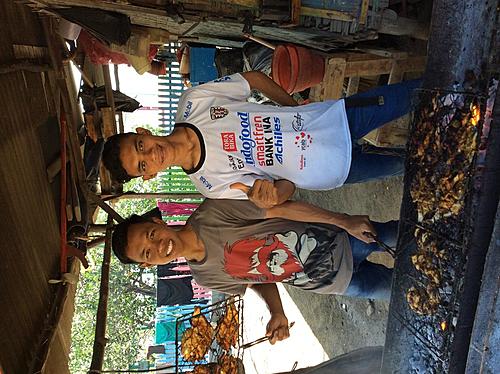
When we reached Post 2 at 900 mt I told Mike that, rather than continue on, I would leave my bike there and hot foot it up to Post 3. He could continue by bike and if he got into strife it wouldn’t be long before I showed up to lend a hand. The signboard indicated that it was 5.5km to Post 3 and the track rose 900 mt over that distance. It didn’t present a problem for me as I’d been running up to 30km in preparation for the Melbourne Marathon a couple of months away.
So the die was cast. I left Mike taking a breather and pushed off at a fast past. I’d fired up my Garmin to keep track of my progress. Mike passed me after I’d gone ten minutes and it wasn’t long before the sound of his engine was absorbed by the breeze.
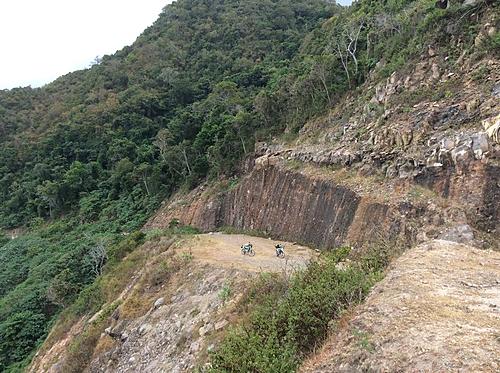
The going underfoot was a bit “iffy”. In other words, if I didn’t watch me feet, I could easily roll an ankle. The growth was often head high and I had to brush it away with a leading arm. At times it was as if I was traipsing through a tunnel in the grass. Thorns growing from trailing vines at ankle height, and sword grass at waist height, were added dangers. Blood seeped from nicks in the backs of my hands. I was forever pushing through greenery; fortunately there were no leeches and the vegetation was dry. The sun shone brightly from a near cloudless sky. I took sips of water and rested only briefly. As each kilometre passed I could see that I was slowing down but I felt strong. It was just the gradient that was slowing me.
An hour passed and I’d covered nearly 4 km of non-stop tramping sustained by a some sweet biscuits washed down with swigs of water. There were some very steep, sandy sections of trail that validated my decision to walk it. The sun, high overhead now, had an in-interrupted view of my progress; it could see I was slowing. I checked my Garmin. Five kilometres covered but still no sign of Post 3. Press on. I took brief rests at the end of each sharp pitch. Whenever I found myself bent over, hands on knees, chest heaving, I forced myself to stand upright and suck in the elixir of life as deeply as possible.
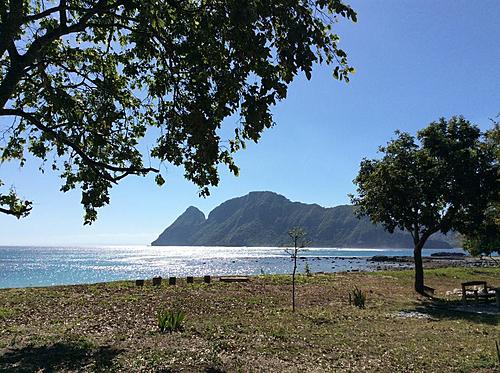
Six kilometres covered. Damn it! I should be there now. Up ahead I could see what looked like a thin metal tower. Maybe that was it. My quadriceps and calves were sending me none too subtle messages that I was going to the well quite often but not drinking very much. The landscape, in all directions, consisted of dun-coloured savannah waving in the strong breeze. It cooled my skin, whisking away perspiration and masked the amount of body fluid I was losing.
I reached the rusting tower, a sort of pylon about 10 meters high. Up ahead, a few hundred meters distant, tucked away in a lee of the mountain side were a couple of shelters - Post 3 at last! Sustained by the welcome sight, and buoyed by a level section of track, I felt a surge of energy and, like a runner entering the stadium at the end of a marathon, I upped my pace and fairly rocketed in to Post 3 and a warm welcome from Mike. He’d just made it up after a few spills and a couple of sections where he had to jump off and run beside the bike - not an easy manoeuvre on a steep, sandy track. It had taken me two hours and nine minutes to cover the 6.64 km climb, almost non-stop, from Post 2. I needed a rest. I collapsed in one of the shelters - wooden platform, four posts supporting a tin roof, no walls - and took a long drink of water.
Stretched out on my back, my body unaccustomed to inertia, began to protest this change in routine. I could feel cramps in my legs, lurking just beneath the surface. Changing position in the slightest was fraught with danger and, sure enough, an attempt to roll on to my side resulted in a locked left hamstring. I began massaging feverishly and somehow got into a sitting position. Mike came over and removed my shoes. Trying to do so myself would have brought on cramp in my quads for sure.
I rested with my back against a corner post. The sky was clear. I could see the peak of Tambora up above and away to the left. Directly above was the lip of the crater - perhaps two hours distant. Three locals, who were at Post 3 to look after a group of police due to commence a training program next day, indicated that the weather was likely to hold for the rest of the day. There was a thick band of cloud way below us and it “had not moved” they said. It was exactly 1pm. Mike looked at me.
“Want to give it a crack?”
My reply was instant. “**** yeah! Let’s do it!”
We really didn’t have much choice as we didn’t have much food and couldn’t afford to gamble on the weather.
“Let me rest for a bit. We’ll set off at 1.30”.
I spent the next half hour massaging my legs and thinking about the final 700mt of the climb. All being well we’d reach the crater lip before 3.30pm. That would give us 30 minutes at the top, time enough to get back down before dark and a little bit up our sleeves for whatever might come our way. Mike gave me a hand to put my shoes back on. I edged myself off the platform and took a few baby steps - gingerly. This climb was going to test my legs for sure. My fitness wasn’t a problem; it was cramp and the thought of enforced halts that bothered me. We didn’t have the luxury of abundant time up our sleeves. I knew how much this trip meant to Mike. To have come so far and not make it would have been too much.
“OK,” I said to Mike. “This is the go. You go ahead and I’ll follow. Stop after 15 minutes and we’ll assess the situation.”
There was a track of sorts for the first few hundreds meters but after that it was more or less a virgin mountain. We stayed on a ridge to the left of which, about 400mt distant, was a line of trees. Mike headed for a single tree - a good landmark for the descent. I plodded on carefully, conscious that one false step necessitating urgent use of muscle to arrest an over balance could result in excruciating cramp and an enforced halt. The ground underfoot was a mixture of black sand and loose scoria. Tough grasses, clumps of stunted high-altitude shrubs and a carpet of edelweiss completed the picture.
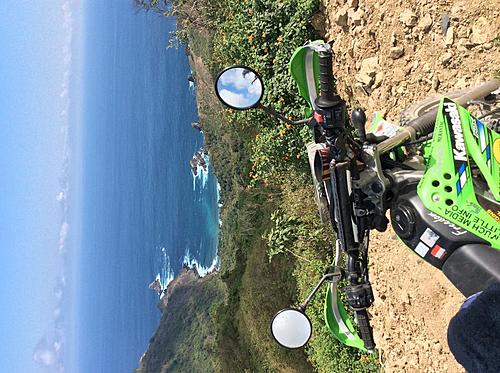
Mike called out to check how I was doing. I waved him on. It didn’t really matter how far ahead of me he got as he would always be able to see me. The mountain was heavily eroded by run off and at times I had to use my hands and grab on to vegetation. It was these steep sections that gave me most grief. I just couldn’t take big step ups. Cramp sat on my shoulder like a black crow portent of doom as I picked out my path with utmost care.
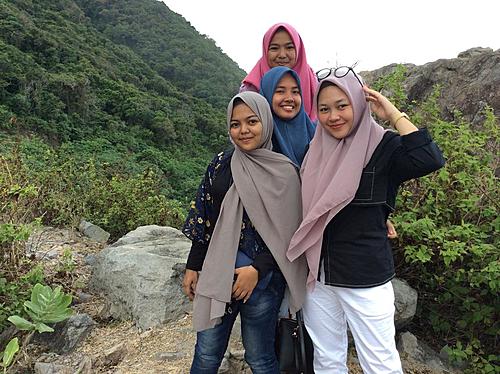
After 30 minutes I took a two minute break before slogging on. I could see Mike up ahead making steady progress. The crater lip still seemed a long way off. I took a longer break. Four minutes and a mouthful of water this time. Refreshing. The gradient was getting tougher. I staggered up the next pitch willing myself not to stop until it levelled out a little. Each time I stopped I massaged my upper thighs and quads furiously. The breaks were coming closer together now. The Law of Diminishing Returns was asserting itself. It was hands and knees work now up a pitch that had really been dug up by the wild pigs that occupied the Park. I made it up this section and spied Mike. He was waving his arms madly and yelling. “This is the top! Not far now!”
The news was just what I needed. Another few minutes and I’d be there. I couldn’t believe it. The end had come quickly. Maybe I was delirious? Had I really heard him say that? I kept climbing, leaning forward, my face nearly pressed into Tambora’s flank. I got down on my hands and knees then heard Mike’s voice. He was twenty metres away.
“You made it. Well done.”
“That was the hardest ****ing thing I’ve ever done.”
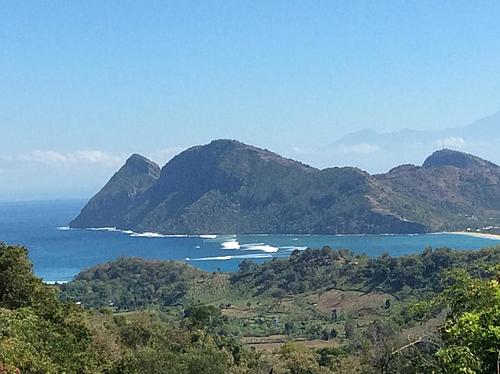
I was exhausted. I got to the crater edge and opened my eyes and looked down into the bowels of the earth. One kilometre deep, seven kilometres across and twenty-one kilometres in circumference - the crater is a thing of wonder. Rent with fissures, its walls almost vertical, it is home to a shallow green lake and a single smouldering vent situated far to the north of where we we situated. The true peak was about two kilometres away and a further 300mt higher.
We took photos and sucked in the view. This was a place that had been part of my imagination since I was a boy pouring over maps in the copy of the Oxford Junior Atlas that my parents had gifted me for my 12th Birthday. It was always impressed that these big mountains were not the sole province of continents; they could just as easily be found on relatively small islands. I remember my excitement at discovering Rinjani - all 3781mts of it - on the tiny island of Lombok. Not that I’d ever want to climb it. Sharing a mountain with 300 other people is not my thing. We were on Tambora and we had it all to ourselves - and that’s the way I like it!
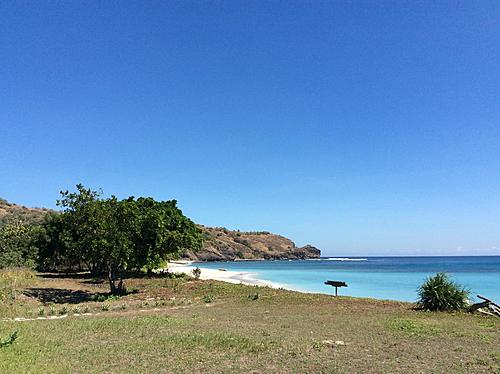
We made it back down to Post 3. Was I fatigued? In a word - yes! One of the locals bought us cups of steaming hot sweet coffee. It was sheer bliss. I sat on the edge of the shelter’s platform and, buffeted by a strong cold wind for the sun had disappeared, I sipped and sipped. Each intake of that sugar-laden beverage went through me like a thousand volt jolt.
My energy stocks replenished, I moved carefully to manoeuvre myself fully clothed into a light weight sleeping bag. Cramp dogged my every move. The shelter’s hard boards were unforgiving. Getting comfortable was an objective which, if it was not secreted somewhere within the wastes of the Takla Makan Desert, lurked in some other God-forsaken spot yet to be discovered by man or beast. To add to our discomfort a freezing wind raged all night. It did its best to rip the sheet iron from the shelter roof. But. the stubborn nails would not let go so we were condemned to listen to a cacophony of rattling tin all night. it was so cold I tucked my hands under my armpits. I may have dozed for an hour. I spent the night begging for daylight to come - which it eventually did.
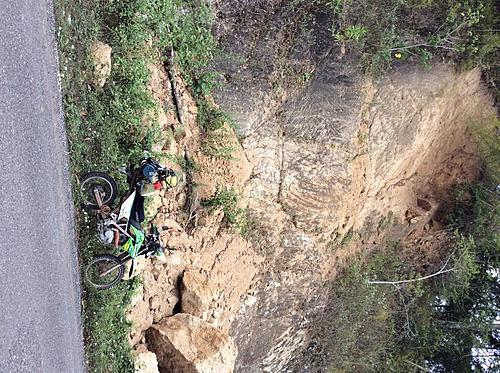
Mike stirred and I bade him good bye for the moment. It was good so be doing something purposeful again. My legs still felt very tired. I tried to maintain a very measured, steady pace. Mike soon caught up and offered me a lift. I declined. I just knew the effort of clinging on the back, using my legs when needed, would result in agonising cramps. I made it to Post 2 in an hour and forty-three minutes. As an experiment I tested how long I could make a mouthful of water last. I was pleased to find that I kept it swilling around while I covered five kilometres. I swallowed it when I got to Post 2.
Mike and I had a pow-wow. The easy option was to spend the night at Homestay Fadillah. The more attractive, but more challenging option, was to make for Kencana Beach Hotel. No prize for guessing which one we chose. We made it back down to the bitumen and reported back to Park Headquarters. We motored in to Fadillah’s yard at 11am. Cleaned up and packed up we bade farewell to Ibu Fatima. We headed straight to out favourite ‘Nasi Padang’ and gorged ourselves on rice with the lot.
Restored, ready for the road and with full tanks we struck out west. A quick stop at Lesehan Santong for coffee and to share photos of our adventure was our only halt. At 5.00pm we rolled up at Kencana and checked in. Then it was straight into the sea to float and let the salt water work its magic.
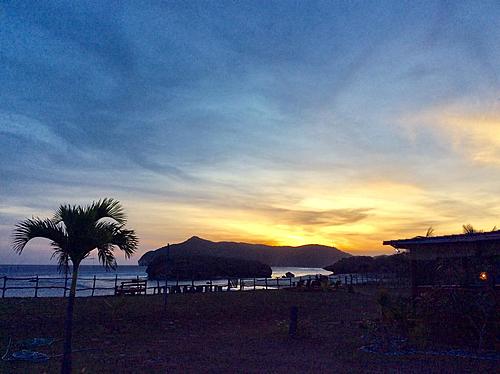
Six o’clock saw us sitting in Kencana’s restaurant watching the sun’s last rays put the day to sleep. For me it was a time of quiet reflection. We had managed to pack a lot in to the past four and a half days. But that’s the way it should be - especially for me. I’m 70 now. I love life with a passion and want to suck the marrow from it before - heaven forbid - I lose my teeth or any of my abilities. Life - we only get one shot at it. Let’s give it our best shot. Thanks Mt Tambora. You gave us an adventure. We won’t ever forget you - or the fine people we met along the way. Bless you one and all for your kindness and humanity to a couple of strangers who appeared in your lives only briefly, but who now will always remember you.
Last edited by kotamarudu; 14 Nov 2020 at 13:50.
|

14 Nov 2020
|
|
Registered Users
HUBB regular
|
|
Join Date: Mar 2009
Location: Moosejaw Canada
Posts: 89
|
|
|
Looking forward to more .
Thanks
|

14 Nov 2020
|
|
Registered Users
HUBB regular
|
|
Join Date: Aug 2007
Location: Australia
Posts: 65
|
|
|
Indonesia: Tambora, The Mountain that Shook Up the World. Part 4
|

18 Nov 2020
|
|
Registered Users
HUBB regular
|
|
Join Date: Aug 2007
Location: Australia
Posts: 65
|
|
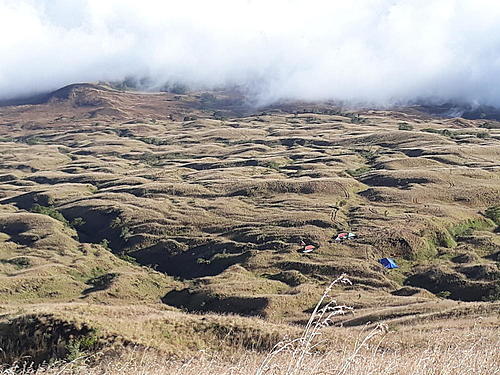
Just tried to upload short video shot by Mike Betts of our trip up Mt Tambora but the link does not work
Here's a photo taken from the crater lip instead. If you blow it up you can see Pos 3 at 1800m about 750m below.
Last edited by kotamarudu; 18 Nov 2020 at 06:09.
Reason: Could not upload YouTube video.
|

18 Nov 2020
|
 |
Registered Users
Veteran HUBBer
|
|
Join Date: Dec 2012
Location: Back into the hamster wheel again, in Oslo - Norway. Did a 5 year RTW trip/250 k kms, 2014-2019
Posts: 1,551
|
|
|
What an achivement and what a write up! Respect!
__________________
In the end everything will be fine. If its not fine its not the end....
|

21 Nov 2020
|
|
Registered Users
HUBB regular
|
|
Join Date: Aug 2007
Location: Australia
Posts: 65
|
|
|
Glad you liked it Kurt. Btw, Daryl is back at work and is driving again. Did you know?
|
|
Currently Active Users Viewing This Thread: 1 (0 Registered Users and/or Members and 1 guests)
|
|
|
 Posting Rules
Posting Rules
|
You may not post new threads
You may not post replies
You may not post attachments
You may not edit your posts
HTML code is Off
|
|
|
|

Check the RAW segments; Grant, your HU host is on every month!
Episodes below to listen to while you, err, pretend to do something or other...

2020 Edition of Chris Scott's Adventure Motorcycling Handbook.
"Ultimate global guide for red-blooded bikers planning overseas exploration. Covers choice & preparation of best bike, shipping overseas, baggage design, riding techniques, travel health, visas, documentation, safety and useful addresses." Recommended. (Grant)

Led by special operations veterans, Stanford Medicine affiliated physicians, paramedics and other travel experts, Ripcord is perfect for adventure seekers, climbers, skiers, sports enthusiasts, hunters, international travelers, humanitarian efforts, expeditions and more.
Ripcord Rescue Travel Insurance™ combines into a single integrated program the best evacuation and rescue with the premier travel insurance coverages designed for adventurers and travel is covered on motorcycles of all sizes.
(ONLY US RESIDENTS and currently has a limit of 60 days.)
Ripcord Evacuation Insurance is available for ALL nationalities.
What others say about HU...
"This site is the BIBLE for international bike travelers." Greg, Australia
"Thank you! The web site, The travels, The insight, The inspiration, Everything, just thanks." Colin, UK
"My friend and I are planning a trip from Singapore to England... We found (the HU) site invaluable as an aid to planning and have based a lot of our purchases (bikes, riding gear, etc.) on what we have learned from this site." Phil, Australia
"I for one always had an adventurous spirit, but you and Susan lit the fire for my trip and I'll be forever grateful for what you two do to inspire others to just do it." Brent, USA
"Your website is a mecca of valuable information and the (video) series is informative, entertaining, and inspiring!" Jennifer, Canada
"Your worldwide organisation and events are the Go To places to for all serious touring and aspiring touring bikers." Trevor, South Africa
"This is the answer to all my questions." Haydn, Australia
"Keep going the excellent work you are doing for Horizons Unlimited - I love it!" Thomas, Germany
Lots more comments here!

Every book a diary
Every chapter a day
Every day a journey
Refreshingly honest and compelling tales: the hights and lows of a life on the road. Solo, unsupported, budget journeys of discovery.
Authentic, engaging and evocative travel memoirs, overland, around the world and through life.
All 8 books available from the author or as eBooks and audio books
Back Road Map Books and Backroad GPS Maps for all of Canada - a must have!
New to Horizons Unlimited?
New to motorcycle travelling? New to the HU site? Confused? Too many options? It's really very simple - just 4 easy steps!
Horizons Unlimited was founded in 1997 by Grant and Susan Johnson following their journey around the world on a BMW R80G/S.
 Read more about Grant & Susan's story
Read more about Grant & Susan's story
Membership - help keep us going!
Horizons Unlimited is not a big multi-national company, just two people who love motorcycle travel and have grown what started as a hobby in 1997 into a full time job (usually 8-10 hours per day and 7 days a week) and a labour of love. To keep it going and a roof over our heads, we run events all over the world with the help of volunteers; we sell inspirational and informative DVDs; we have a few selected advertisers; and we make a small amount from memberships.
You don't have to be a Member to come to an HU meeting, access the website, or ask questions on the HUBB. What you get for your membership contribution is our sincere gratitude, good karma and knowing that you're helping to keep the motorcycle travel dream alive. Contributing Members and Gold Members do get additional features on the HUBB. Here's a list of all the Member benefits on the HUBB.
|
|
|
 9Likes
9Likes



















































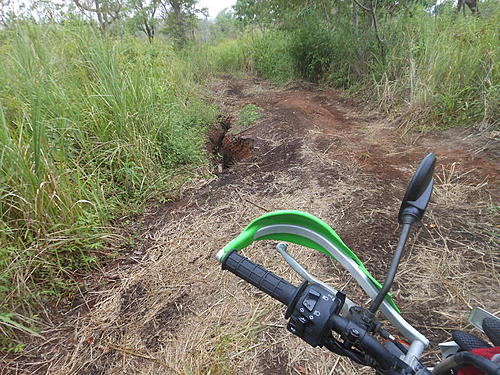
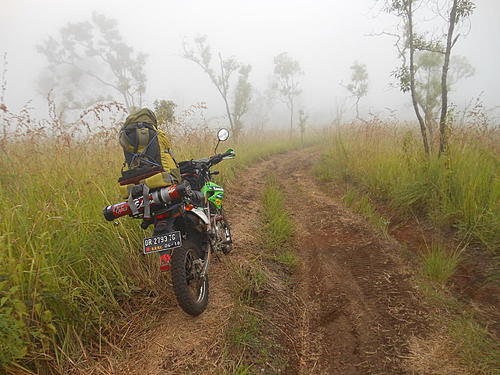
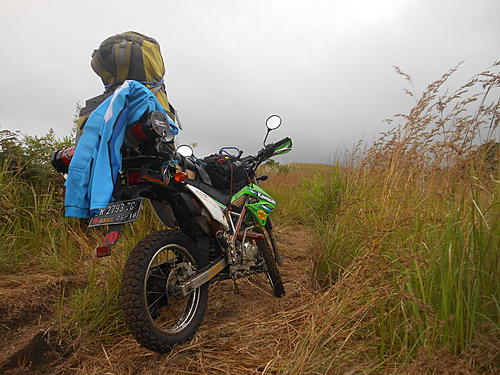
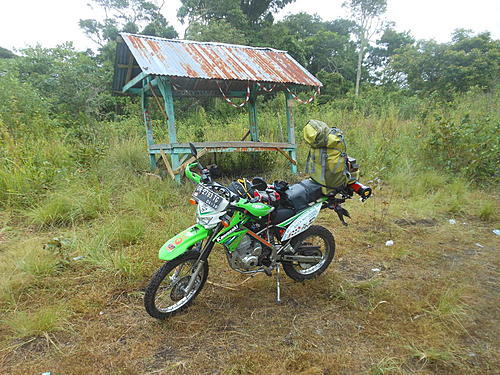
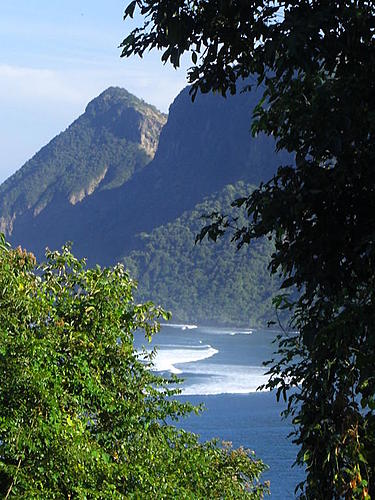
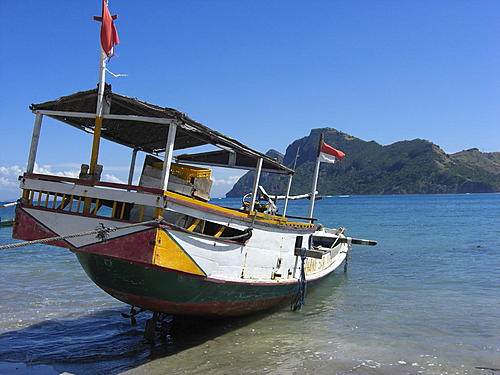
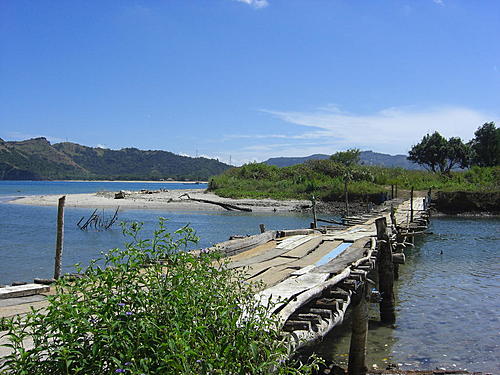
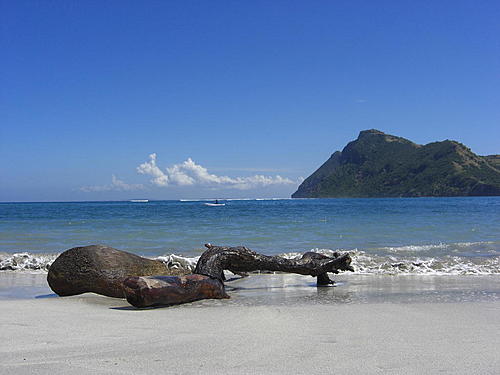
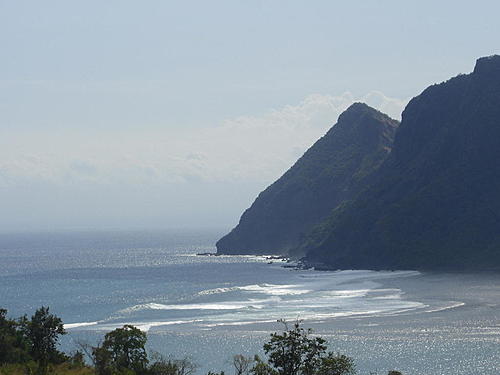

 Linear Mode
Linear Mode










